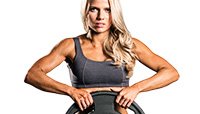Training as a powerlifter under the great Rick Hussey at Big Iron Gym was one of the greatest opportunities in my life. Rick built powerlifters like a mechanic built fast, powerful engines. As a powerlifting coach, he knew how to get you to move weight from A to B using all of the power and explosion your body could release, and to do it time after time in that same sweet groove. It was like your body was a piston, performing each rep the same way every time.
Rick taught me that the way to keep increasing your strength was to always train the weaker parts of your lifts. In return it would improve your entire lift. The weak areas might move around in time, but if you adjust your training to your weak spots, you can keep getting stronger.
While powerlifting, we trained heavy every workout, five days per week, and we always handled heavy weight on all of our movements. Most of our reps were doubles and singles on squats and bench press. On deadlift it was a bit different. I trained with more volume at the beginning of my training cycle and tapered down the closer I got to a meet. We always tried to lift explosively because the faster you can get the weight from A to B, the more power you have.
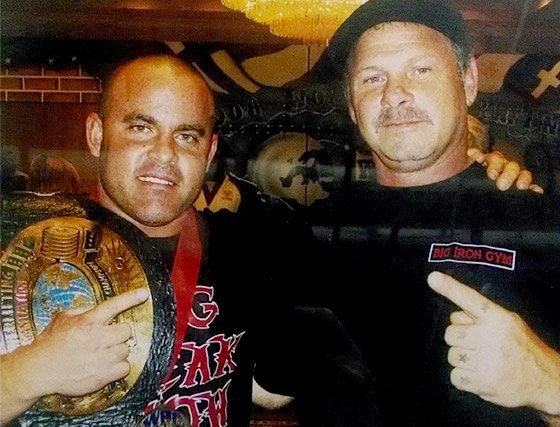
I love powerlifting and always will, but when Rick passed, I just didn't have the same desire to do it anymore. It just didn't feel the same without him, and I had been getting injured quite a bit in those last two years. I felt then that I was almost lifting for Rick. I know how much powerlifting meant to him, and he once told me he was living through me. If he were still here today, I'm sure I'd still be doing it.
Then there was bodybuilding—a new adventure! It was something I'd always wanted to try. I've focused on bodybuilding now for almost three years. This is my journey.
Eating For Competing

My diet while powerlifting was pretty much to eat as much as I want of whatever I want, but make sure to get as much protein as possible every day. There wasn't a strict routine. I knew where I wanted to keep my bodyweight and I tried to keep it in that range, depending on which weight class I was trying to make. I got to eat all the goodies. Ice cream was always at the top of my list.
So when I decided to do a show, I started dieting for it. I stuck with the diet for about a month, but it was clear that I was dropping weight too fast. I was losing muscle, I felt flat, and I just wasn't eating enough. At that point, I got in touch with a friend of Rick's named Todd Smith. He had been Mr. Natural Olympia several times, so I jumped at the opportunity to work with him. Todd took me under his wing and shared a lot of his training and diet knowledge with me.
Todd's way of dieting was mainly about food choices. He wants your stomach to do a lot of the work. A lot of people have you start out eating clean and doing cardio, but Todd likes to get your stomach and your body working for you so you don't have to do as much cardio and so you can keep as much muscle as possible.
He set up a baseline diet for me, which included all of the typical bodybuilding foods. For protein, he had me eat steak, chicken, fish, eggs, and ground turkey. Carb sources were oatmeal, cream of wheat, sweet potatoes, and brown rice. And of course, I ate all kinds of greens: broccoli, asparagus, spinach, etc. These foods are staples in my diet, both in the offseason and going into a show; Todd simply adjusts the amounts.
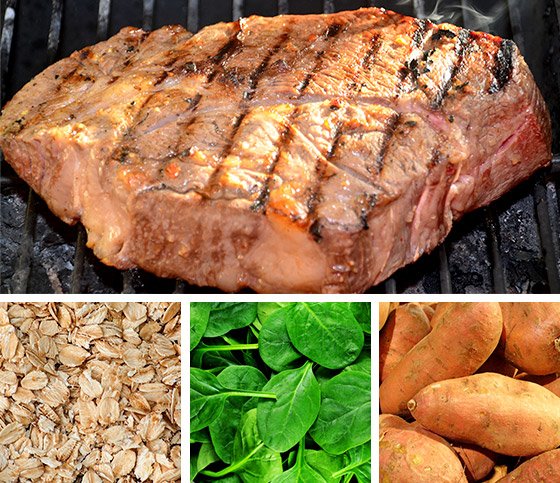
Under Todd's guidance, I started eating more food and my muscles filled back out, and at the same time I was getting leaner. I'd never eaten so much food before. I had to work up to eating that frequently and in those portion sizes so my body could recover from workouts and put on muscle. I was eating a lot of food every couple of hours, so my stomach was always working and burning lots of food. The eating is the hardest part about bodybuilding.
That was the baseline diet. From here, Todd made small adjustments as the show approached, lowering fats and carbs. He didn't lower protein too much; he just opted for different sources. For example, he had me switch from steak to chicken and then to fish. A lot of times people make drastic changes, but Todd believes in making the smallest amount of change in the diet to yield the greatest amount of change in the body. This allowed me to lose fat, but fill out at the same time.
He threw in cardio toward the end as a final step for getting ready for the show. That's another thing: When people do cardio all the time, it loses its effectiveness. When they stop doing it, they gain weight. By saving cardio until the end, it's more effective.
Dialing It In
I dieted for a total of 20 weeks for my first show. I came in as a light heavyweight, weighing in at 190 pounds, 7 below the upper limit. I placed first in my weight class, but I didn't win the overall. Over the course of the diet I was able to put on muscle while losing fat, mainly because I was eating so much.
I did a second show where I dieted down to the middleweights, weighing in at the upper limit of 176 pounds. I did have to lose some muscle to do it, but I still won my weight class. I just wanted to see if I could do it because I knew I wouldn't be able to get down to middleweight again, since my body would keep growing due to the way I'm eating.
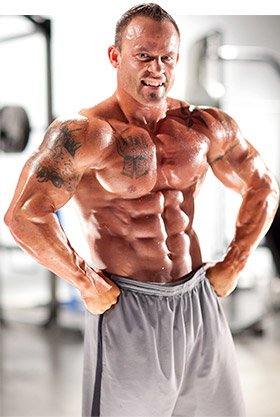
Looking back to my powerlifting career, I never realized how much eating correctly could have helped me. It helps your muscles recover faster because they get the nutrients they need. I could have held more muscle and less fat. I weigh about 220 right now, which is about the biggest I ever was while powerlifting, but I look like a different person. As a 220-pound powerlifter, I was bloated and I have no idea what my body fat percent was. Now at 220, I'm probably 9 or 10 percent body fat, and I look like a bodybuilder.
Because of the kinds of food I eat now, I feel healthier. When I was powerlifting, my blood pressure was high. All I kept track of was my protein. I'd eat anything, including a lot of bad things—like sugar and ice cream. When I first cleaned up my diet, my body craved all the bad foods I used to eat. After a short period of eating healthy, I didn't crave the bad stuff anymore.
When I did have cheat meals, I couldn't eat that much bad food or I would feel sick. I remember eating so much junk after my first bodybuilding show that I was up puking all night. I just couldn't stop eating because it tasted so good. That didn't happen again after my next show! Don't get me wrong, I have cheat meals, but I'm consistent Monday through Friday. Overall I feel much healthier and it has become a part of my lifestyle.
Making The Training Transition
One of the hardest parts of the transition was learning how to train to failure. I was used to moving weight from A to B, as opposed to focusing on keeping all of the tension on my muscles the entire lift until I couldn't do any more reps, then using a spotter to do forced reps. I did some isolation movements when I was powerlifting, but the focus was always on moving as much weight as I could. I've learned that bodybuilding is all about bringing as much blood into the muscle as possible so it can grow.
I slowed down. I focus not just on pushing the weight up, but on controlling it down, flexing the muscle as I push weight up, and then squeezing at the top, always keeping tension on the particular muscle I'm trying to develop. Most people don't realize how important the up, down, and squeeze of each rep are. Before, I'd go as heavy as I could and aim for a certain number of reps, but I've since learned that I can make just about any weight effective by doing the rep strictly and by flexing throughout the entire movement.
For powerlifting we did singles, doubles, and triples. Now I do reps from 10-to-12, and up to 20 for leg movements, but the reps are performed differently. I'll use the leg press as an example. The key is to not lock the legs out at the top because that takes tension off the quads. I'll lower it under control, use my muscles to stop the weight, then push it up under control, and stop three-quarters of the way up. When I work my quads, I want the tension on my quads the whole time. You have to fill up the muscle with blood and stretch out the fascia. It has to hurt. I do this with all my isolation movements.
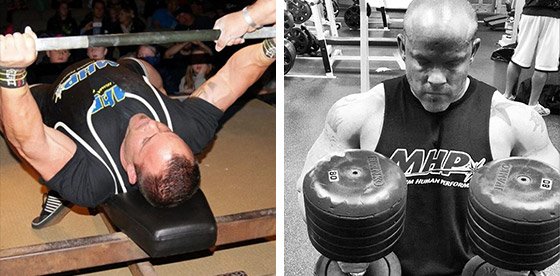
My body has always responded well to heavy lifting. I still need and want to handle heavy weight on my main movements like squat, bench press, and deadlift. I'll still do some of those in a powerlifting way, moving weight from A to B, but my reps are between 5 and 10. This keeps the density of my muscles and it helps me keep separation in my muscles. Of course, after I do those lifts I do lots of higher volume sets on isolation exercises in order to drive blood into the muscles and force them to grow. By combining training aspects from both powerlifting and bodybuilding, I'm able to get full, dense, separated muscles.
It's hard to compare my strength levels now to what they were when I was powerlifting because I never really max out. I don't train as heavy as I did when I was powerlifting. I don't use any gear. I don't go as heavy because I don't need to—although with deadlifts, I still pull heavy enough. I've done 735 for a triple, whereas with powerlifting, my best was 780 in a meet. But when I train heavy now on squat and bench, I'll do 5-10 reps. I'll try to go as heavy as I can, but it's not as heavy as I could do for one to three reps. So I can't really compare.
Staying Connected To Strength
I recently started doing some raw bench meets. My good friend Rob Luyando introduced me to the Relentless powerlifting meet, which is a meet to raise money to support kids with life-threatening illnesses. When he asked me to do this meet, I couldn't say no. For me it is all for the kids and putting smiles on their faces for the short time we get to interact with them, and letting their families know that there are people who care about them and their situations. At the same time, I can't help but think of my great friend and coach Rick Hussey who passed away three years ago from cancer. I know he is smiling down on us as we lift for a great cause, and I will always lift for him when I get up on the platform.
Relentless Detroit was in November. I only trained for a month for it. Before then, I'd been retired from powerlifting. I fared decent—I weighed in around 216 or 217 and ended up benching 540 raw. Next up, I did the Relentless meet in Minneapolis. I had longer to train for this one, so I hoped to bench closer to 570. My raw bench is almost as strong as it was before.
Shawn "Freakshow" Frankl 540 raw bench press at Relentless Detroit 2013!
Watch The Video - 2:38
As I mentioned before, I was getting injured a lot in my last two years of powerlifting. Now that I'm bodybuilding, I still get injured because I still train hard, but it's different. When I was powerlifting, every day when I got out of bed my muscles had a deep, bad, hurt feeling, like I'd been hit by a truck. I felt deep, to-the-bone sore, like tendons. But now, my muscles just feel sore normally (except when I tear them). Now, I feel exhausted when I leave the gym and it's my muscles that feel sore, but not my bones and tendons (except when I push it too far). I need to get better at listening to my body and not doing that crap.
Gaining Perspective
Even with all I've learned about training for bodybuilding, I don't know that I'd change anything with how I trained for powerlifting. What we were doing worked—it just beat the hell out of you. It's like playing in the NFL. No matter how you train, after 10 years you're going to be beat up. My goal at the time was to be the best, and my training got me what I wanted. I'd like to say that I would have taken more down weeks, but what if I hadn't accomplished what I did? My training worked, and I continually got stronger from year to year. But the heavier you go, the more beat up you'll get, and that's a fact. Especially considering that I was a smaller guy, I wasn't a 300-plus-pounder.
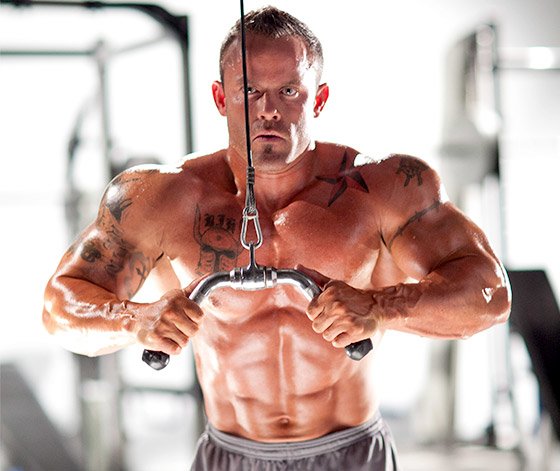
For me, all of this is about more than just powerlifting or bodybuilding. When you commit to something and you say you're going to do something, you need to finish it. I don't care what happens, you need to follow through. Case in point, about two or three weeks out from my first show, I tore part of my quad while squatting 550 for reps. My leg was all black and blue, from the top of my leg down to my calf. I had them paint over it so you couldn't tell, but unfortunately my leg didn't have any definition because it was swollen. No matter. If you tear one quad, show the other! And that's what bodybuilding is all about: hiding your weak spots and showing your good ones. It worked, because I still won.
When it comes to competing, you'll never be satisfied with where you are. You want to be at your best, but you'll never be there. You still need to do it.
Recommended For You
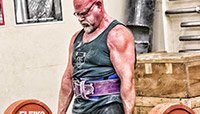
It's Never Time To Quit: Do What You Love For Life
Robert Wanamaker lives and lifts with a rare disease called DISH that constantly threatens to end his strongman career. He won't give up, and neither should you.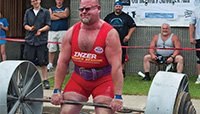
Playing My Cards: How I Live And Lift Through The Pain Of DISH
Even though his body tries to break his spirit every day, this strongman refuses to give up. Every lift renews his vigor and drives his right to exercise life.